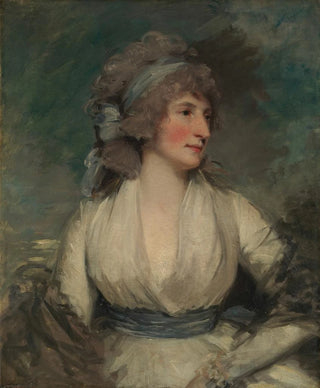Art print | Portrait of a woman - John Hoppner


View from behind

Frame (optional)
Portrait of a Woman - John Hoppner – Captivating Introduction
The "Portrait of a Woman" by John Hoppner is a work that transcends the simple frame of a pictorial representation to immerse the viewer in a universe of grace and mystery. Created at the end of the 18th century, this painting embodies the very essence of British art of its time, skillfully blending elegance and psychological depth. Through this portrait, Hoppner manages to capture not only the external appearance of his model but also a part of her soul, inviting the audience to reflect on the identity and story of this enigmatic woman. The soft light caressing her face, along with the refined details of her attire, creates an intimate atmosphere that captivates anyone who lingers on it.
Style and uniqueness of the work
Hoppner's style is distinguished by its delicate approach and mastery of nuances. In this portrait, the chosen color palette evokes a subtle harmony, where warm tones blend with delicate shadows, giving the figure an almost lifelike dimension. The sfumato technique, found in the works of great Renaissance masters, is here reinterpreted with a modernity that is the strength of this painting. The woman's facial features, both gentle and determined, reveal a complex personality, oscillating between shyness and confidence. Hoppner succeeds in creating a dialogue between the model's gaze and that of the viewer, making the contemplative experience all the more immersive. Every detail, from the sparkling jewelry to the texture of the drapery, is carefully crafted, demonstrating an exceptional craftsmanship that makes this work a true masterpiece.
The artist and his influence
John Hoppner, born in 1758, is one of the most prominent portraitists of his time, often compared to his contemporary Thomas Gainsborough. His career, marked by a meteoric rise, reflects undeniable talent and a unique artistic sensitivity. Hoppner skillfully navigated between the demands of high British society and his own desire for innovation, incorporating elements of emerging Romanticism into his works. His influence extends far beyond

Matte finish

View from behind

Frame (optional)
Portrait of a Woman - John Hoppner – Captivating Introduction
The "Portrait of a Woman" by John Hoppner is a work that transcends the simple frame of a pictorial representation to immerse the viewer in a universe of grace and mystery. Created at the end of the 18th century, this painting embodies the very essence of British art of its time, skillfully blending elegance and psychological depth. Through this portrait, Hoppner manages to capture not only the external appearance of his model but also a part of her soul, inviting the audience to reflect on the identity and story of this enigmatic woman. The soft light caressing her face, along with the refined details of her attire, creates an intimate atmosphere that captivates anyone who lingers on it.
Style and uniqueness of the work
Hoppner's style is distinguished by its delicate approach and mastery of nuances. In this portrait, the chosen color palette evokes a subtle harmony, where warm tones blend with delicate shadows, giving the figure an almost lifelike dimension. The sfumato technique, found in the works of great Renaissance masters, is here reinterpreted with a modernity that is the strength of this painting. The woman's facial features, both gentle and determined, reveal a complex personality, oscillating between shyness and confidence. Hoppner succeeds in creating a dialogue between the model's gaze and that of the viewer, making the contemplative experience all the more immersive. Every detail, from the sparkling jewelry to the texture of the drapery, is carefully crafted, demonstrating an exceptional craftsmanship that makes this work a true masterpiece.
The artist and his influence
John Hoppner, born in 1758, is one of the most prominent portraitists of his time, often compared to his contemporary Thomas Gainsborough. His career, marked by a meteoric rise, reflects undeniable talent and a unique artistic sensitivity. Hoppner skillfully navigated between the demands of high British society and his own desire for innovation, incorporating elements of emerging Romanticism into his works. His influence extends far beyond






